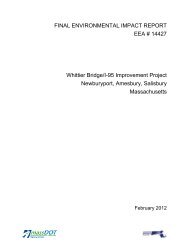Herbicide Alternatives Research - Executive Office of Transportation
Herbicide Alternatives Research - Executive Office of Transportation
Herbicide Alternatives Research - Executive Office of Transportation
Create successful ePaper yourself
Turn your PDF publications into a flip-book with our unique Google optimized e-Paper software.
Mowing. Clearly, the most common cultural practice employed along roadsides is mowing,<br />
particularly in Zone 2, the Safety Clear Zone. The frequency and height <strong>of</strong> mowing varies from<br />
one state to another. Connecticut and Rhode Island maintain a minimum mowing height <strong>of</strong> 3<br />
inches. Mowing begins when vegetation reaches a height <strong>of</strong> 6 inches. Generally, this practice<br />
results in mowing 2 to 3 times per year. New Hampshire mows grass areas along open highways<br />
at a cutting height <strong>of</strong> 6 inches, but in more traveled areas near population centers, cutting height<br />
is reduced to 2 inches (Giunta, 2004). For most New Hampshire highways, grassed areas are<br />
mowed twice per year.<br />
It is generally accepted that mowing high, at least 4 to 6 inches, can reduce stress on grass plants.<br />
Mowing at high-cutting levels improves vigor <strong>of</strong> grass growth and reduces the frequency <strong>of</strong><br />
mowing to twice a year or less. High-cut grass also retards growth <strong>of</strong> weed species and hinders<br />
the establishment <strong>of</strong> woody species. Gover (2003) suggested that too many highway managers<br />
are overly concerned with the aesthetics <strong>of</strong> roadside plantings and mow too frequently at too-low<br />
cutting heights. This perception, he contends, complicates roadside vegetation management and<br />
interferes with the control <strong>of</strong> weeds.<br />
Mowing is also the primary method for eliminating many invasive species that may establish in<br />
Safety Clear zones.<br />
Brushing. The Maine DOT does not favor mechanical methods such as bush hogging (mowing<br />
<strong>of</strong> brush with heavy-duty, power-driven, rotary cutters). The 2001 report from the Maine DOT<br />
(Moosman, 2001), stated that mechanical methods <strong>of</strong> brush control (mowing or bush hogging)<br />
are more expensive than spraying and result in higher stem counts over time from regrowth <strong>of</strong><br />
brush if no treatment <strong>of</strong> cut stems is done. However, hand removal <strong>of</strong> brush (brush cutting) is<br />
more expensive than mowing with the added issue <strong>of</strong> worker safety. Also, mechanical and handcutting<br />
methods with the use <strong>of</strong> power equipment increase the potential for environmental risk<br />
from fuels and oils (Moosmann, 2001). Maine is using a growth regulator, Krenite S (du Pont,<br />
Wilmington, Del.), to control brush (Moosman 2003).<br />
An example <strong>of</strong> an integrated vegetation management approach to brush control is described by<br />
Gover et al. (2004). They describe mechanical, cultural, and chemical options for controlling<br />
tree-<strong>of</strong>-heaven (Ailanthus altissima Swingle). Similar management options apply to species such<br />
as black locust (Robinia pseudoacacia L.), sassafras (Sassafras albidum Nees.), and sumac (Rhus<br />
typhina Turner) that occur along roadsides and that regrow readily form sprouts on cut stumps.<br />
In a study investigating mechanical, chemical, and combination <strong>of</strong> mechanical and chemical<br />
brush control in Ontario, Canada, Puttock (1994) concluded that cutting followed by the<br />
application <strong>of</strong> herbicide to the cut surfaces or regrowth was the most cost-effective systems for<br />
reducing the density and proportion <strong>of</strong> stems greater than one-yard tall.<br />
Thermal. Principles <strong>of</strong> using heat to control weeds are discussed by Daar (2004). Currently<br />
none <strong>of</strong> the New England states are using flame or steam-hot water techniques along highways.<br />
However, Vermont has run trials using wet infrared thermal technology along railroad rights <strong>of</strong><br />
way (Burnham et al., 2003). This report notes that wet infrared thermal treatment exposes weeds<br />
to high temperatures, thereby denaturing proteins and rupturing cell walls. The resultant injuries<br />
disable normal plant functions and destroy shoots. The treatment can be effective in killing<br />
18
















